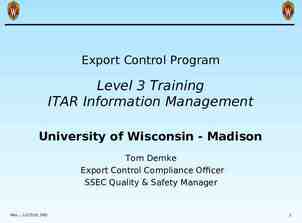CHAPTER 16 SOLUTIONS Jennie L. Borders
39 Slides2.27 MB
CHAPTER 16 SOLUTIONS Jennie L. Borders
SECTION 16.1 – PROPERTIES OF SOLUTIONS Solutions are homogeneous mixtures that can be solids, liquids, or gases. Remember: The solvent dissolves the solute. Three factors that determine the rate a which a solute dissolves are stirring (agitation), temperature, and the particle size of the solute.
STIRRING/AGITATION Stirring a solution speeds up the rate of dissolving because it disperses the solute and brings the solute in contact with all of the solvent particles.
TEMPERATURE Increasing the temperature of the solution usually increases the rate at which a solid solute dissolves because the particles are moving faster.
PARTICLE SIZE/SURFACE AREA Dissolving only occurs at the surface of a particle. The smaller the particles, the more surface area the solvent can dissolve.
SOLUBILITY Solubility is the amount of solute that dissolves in a given quantity of solvent at a specific temperature. Solubility is often expressed in grams of solute per 100g of solvent.
UNSATURATED An unsaturated solution contains less than the maximum amount of solute at a given temperature. If more solute is added, then it will dissolve.
SATURATED A saturated solution contains the maximum amount of solute at a given temperature. If more solute is added, then it will settle at the bottom.
SUPERSATURATED A supersaturated solution contains more than the maximum amount of solute at a given temperature. A supersaturate solution is extremely unstable. If more solute is added, then a fast recrystallization of the previously dissolved solute occurs.
SUPERSATURATED Solubility of a solid solute tends to increase with temperature. A supersaturated solution is made by heating the solvent and adding the maximum amount of solute at the elevated temperature. If the solution is CAREFULLY cooled, then you can form a supersaturated solution.
LIQUID SOLUTIONS Two liquids that will dissolve each other are miscible. Ex: vinegar and water Two liquids that will not dissolve one another are immiscible. Ex: oil and water
FACTORS AFFECTION SOLUBILITY OF A SOLID As temperature increases, the solubility of a solid solute tends to increase. A change in pressure does not affect the solubility of a solid solute.
FACTORS AFFECTING THE SOLUBILITY OF A GAS As temperature increases, the solubility of a gas tends to decrease. The gas particles need to be as slow as possible to force them into a liquid solvent. As pressure increases, the solubility of a gas tends to increase because we are forcing the particles into the liquid.
SECTION 16.1 ASSESSMENT 1. What units are usually used to express the solubility of a solute? 2. What would you do to change a saturated solution to an unsaturated solution?
SECTION 16.2 – CONCENTRATIONS OF SOLUTIONS The concentration of a solution is the measure of the amount of solute that is dissolved in a given amount of solvent. A dilute solution is one that contains a small amount of solute. A concentrated solution is one that contains a large amount of solute.
MOLARITY Molarity (M) is the number of moles of solute dissolved in one liter of solution. Molarity moles of solute liters of solution
SAMPLE PROBLEM 1. Intravenous (IV) saline solutions are often administered to patients in the hospital. One saline solution contains 0.90g NaCl in exactly 100mL of solution. What is the molarity of the solution? 0.90g NaCl x 1mol NaCl 0.016 mol NaCl 58g NaCl Molarity mol 0.016 mol NaCl 0.16M NaC L 0.1L
PRACTICE PROBLEMS 1. A solution has a volume of 2.0L and contains 36.0g of glucose (C6H12O6). What is the molarity of the solution? 0.1M C6H12O6 2. A solution contains a volume of 250mL and contains 0.70mol NaCl. What is its molarity? 2.8M NaCl
SAMPLE PROBLEM 1. Household laundry bleach is a dilute aqueous solution of sodium hypochlorite. How many moles of solute are present in 1.5L of 0.70M NaClO? M mol , so mol M x L L mol 0.70M x 1.5L 1.1 mol NaClO
PRACTICE PROBLEMS 1. How many moles of ammonium nitrate are in 335mL of 0.425M NH4NO3? 0.142 mol NH4NO3 2. How many grams of solute are in 250mL of 2.0M CaCl2? 56g CaCl2
DILUTIONS Diluting a solution reduces the number of moles of solute PER volume, but does not change the total number of moles of solute in solution. For a dilution, more solvent is added. M1V1 M2V2
SAMPLE PROBLEM 1. How many milliliters of aqueous 2.00M MgSO4 solution must be diluted with water to prepare 100.0mL of aqueous 0.400M MgSO4? 2.00M M1V1 M2V2 , so V1 M2V2 ? M1 0.400M V1 0.400M x 100.0mL 20mL 100.0mL 2.00M
PRACTICE PROBLEMS 1. How many milliliters of a solution of 4.00M KI are needed to prepare 250.0mL of 0.760M KI? 47.5mL 2. How could you prepare 250mL of 0.20M NaCl using only a solution of 1.0M NaCl 50mL of 1.0M NaCl in 250mL of solution and water?
PERCENT SOLUTIONS The concentration of a solution can also be expressed by percent by volume or the percent by mass of the solute. Percent by volume (%v/v) volume of solute x 100 volume of solution Percent by mass (%m/m) mass of solute x 100 mass of solution
SAMPLE PROBLEM 1. What is the percent by volume of ethanol in the final solution when 85mL of ethanol is diluted to a volume of 250mL with water? olume solute 85mL olume solution 250mL v/v volume solute x 100 85mL x 100 34 volume soln. 250mL
PRACTICE PROBLEMS 1. A bottle of hydrogen peroxide is labeled 3.0% (v/v). How many mL H2O2 are in a 400.0mL bottle of this solution? 12mL 2. Suppose you want to make 2000g of a solution of glucose in water that has a 2.8% (m/m) concentration. How much glucose should you use? 56g
SECTION 16.2 ASSESSMENT 1. How do you calculate the molarity of a solution? 2. Compare the number of moles of solute before dilution with the number of moles of solute after dilution. 3. Calculate the molarity of a solution containing 0.627M CuSO4 400g CuSO4 in 4.00L of solution. 4. How many moles of solute are present in 50.0mL of 0.20M KNO 0.01 mol 3? KNO3
SECTION 16.2 ASSESSMENT 5. How many milliliters of a stock solution of 2.00M KNO3 would you need to prepare 100.0mL of 0.150M KNO3? 7.50mL 6. What is the concentration, in percent (v/v), of a solution containing 50mL of diethyl ether in 2.5L of solution? 2.0% 7. How many grams of K2SO4 would you need to prepare 1500g of 5.0% K2SO4 (m/m) solution? 75g
SECTION 16.3 – COLLIGATIVE PROPERTIES A property that depends only upon the number of solute particles (not the type) is called a colligative property. Three colligative properties are vapor pressure depression, freezing point depression, and boiling point elevation.
SOLUTE-SOLVENT ATTRACTIONS
VAPOR PRESSURE DEPRESSION Vapor pressure is the pressure of a vapor above a liquid. The vapor pressure decreases when solute particles are added because the solvent particles are attracted to the solute particles, so they do not want to leave the solution and become a vapor.
FREEZING POINT DEPRESSION When a substance freezes, the particles must get in an orderly arrangement to form the solid. The freezing point lowers because when a solute is added, the solvent particles are attracted to the solute, so they do not want to get in that orderly arrangement. The temperature must be lowered to force them into the solid arrangement.
BOILING POINT ELEVATION The boiling point increases because when a solute is added, the solvent particles are attracted to the solute, so they do not want to leave the solution and become a gas. The temperature must be raised to force them to become a gas.
COLLIGATIVE PROPERTIES Remember the colligative properties are based on the number of solute particles not the type of particles. The solute particles could be atoms, ions, or molecules. You must remember that ionic compounds will break into ions when dissolved in water. Ex: CaCl2 Ca 2 Cl- Cl- 3 particles
SAMPLE PROBLEM 1. Which solution has the higher boiling point? Solution A Solution B 3 mol MgSO 1 mol Al O 4 2 3 Al2O3 MgSO4 3 -2 2 -2 2Al 3O Mg SO4 2 particles x 3 mol 5 particles x 1 mol 5 mol of particles 6 mol of particles Solution A has the higher boiling point.
PRACTICE PROBLEMS 1. Which solution has the lower freezing point? Solution A Solution B 3 mol N2O5 2 mol Ca(NO3)2 2. Which solution has the higher vapor pressure? Solution A Solution B 1 mol NH4NO3 1 mol AlBr3
SECTION 16.3 ASSESSMENT 1. What are three colligative properties? 2. What factor determines how much the vapor pressure, freezing point, and boiling point of a solution differ from those properties of the pure solvent? 3. Would a dilute or a concentrated sodium fluoride solution have a higher boiling point? Explain.
SECTION 16.3 ASSESSMENT 4. An equal number of moles of KI and MgI2 are dissolved in equal volumes of water. Which solution has the higher a. Boiling point? b. Vapor pressure? c. Freezing point?
THE END












































